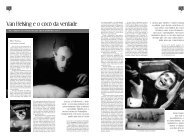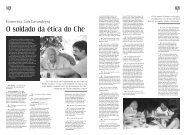Merleau-Ponty, 1964. Eye and mind. - Biolinguagem
Merleau-Ponty, 1964. Eye and mind. - Biolinguagem
Merleau-Ponty, 1964. Eye and mind. - Biolinguagem
- No tags were found...
Create successful ePaper yourself
Turn your PDF publications into a flip-book with our unique Google optimized e-Paper software.
pursuing depth, what Cézanne is seeking is this deflagration of Being, <strong>and</strong> it is all in the<br />
modes of space, <strong>and</strong> in form as well. Cézanne already knew what cubism would restate:<br />
that the external form, the envelope, is secondary <strong>and</strong> derived, that it is not what makes a<br />
thing to take form, that that shell of space must be shattered—the fruit bowl must be<br />
broken. But then what should be painted instead Cubes, spheres, <strong>and</strong> cones—as he<br />
said once Pure forms having the solidity of what could be defined by an internal law of<br />
construction, forms which taken together, as traces or cross-sections of the thing, let it<br />
appear between them like a face in the reeds This would be to put Being's solidity on<br />
one side <strong>and</strong> its variety on the other. Cézanne had already made an experiment of this<br />
kind in his middle period. He went directly to the solid, to space—<strong>and</strong> came to find that<br />
inside this space—this box or container too large for them—the things began to move,<br />
color against color; they began to modulate in the instability. 36 Thus we must seek space<br />
<strong>and</strong> its content together. The problem becomes generalized; it is no longer solely that of<br />
distance, line, <strong>and</strong> form; it is also, <strong>and</strong> equally, the problem of color.<br />
Color is the "place where our brain <strong>and</strong> the universe meet," he says in that admirable<br />
idiom of the artisan of Being which Klee liked to quote. 37 It is for the sake of color that we<br />
must break up the form qua spectacle. Thus the question is not of colors, "simulacra of<br />
the colors of nature." 38 The question, rather, concerns the dimension of color, that<br />
dimension which creates—from itself to itself—identities, differences, a texture, a<br />
materiality, a something….<br />
Yet there is clearly no one master key of the visible, <strong>and</strong> color alone is no closer to being<br />
such a key than space is. The return to color has the virtue of getting somewhat nearer to<br />
"the heart of things, " 39 but this heart is beyond the color envelope just as it is beyond the<br />
space envelope. The Portrait of Vallier sets white spaces between the colors which take<br />
on the function of giving shape to, <strong>and</strong> setting off, a being more general than yellow-being<br />
or green-being or blue-being. Similarly, in the water colors of Cézanne's last years, space<br />
(which had been taken to be self-evidence itself <strong>and</strong> of which it was believed that the<br />
question of where was not to be asked) radiates around planes that cannot be assigned<br />
to any place at all: "a superimposing of transparent surfaces," "a flowing movement of<br />
planes of color which overlap, advance <strong>and</strong> retreat." 40<br />
As we can see, it is not a matter of adding one more dimension to those of the flat<br />
canvas, of organizing an illusion or an objectless perception whose perfection consists in<br />
simulating an empirical vision to the maximum degree. Pictorial depth (as well as painted<br />
height <strong>and</strong> width) comes "I know not whence" to alight upon, <strong>and</strong> take root in, the<br />
sustaining support. The painter's vision is not a view upon the outside, a merely<br />
"physical-optical" 41 relation with the world. The world no longer st<strong>and</strong>s before him through<br />
representation; rather, it is the painter to whom the things of the world give birth by a sort<br />
of concentration or coming-to-itself of the visible. Ultimately the painting relates to nothing<br />
at all among experienced things unless it is first of all "autofigurative. " 42 It is a spectacle<br />
of something only by being a "spectacle ofnothing," 43 by breaking the "skin of things" 44 to<br />
show how the things become things, how the world becomes world. Apollinaire said that<br />
in a poem there are phrases which do not appear to have been created, which seem to<br />
have shaped themselves. And Henri Michaux said that sometimes Klee's colors seem to<br />
have been born slowly upon the canvas, to have emanated from some primordial ground,<br />
"exhaled at the right spot" 45 like a patina or a mold. Art is not construction, artifice, the<br />
meticulous relationship to a space <strong>and</strong> a world existing outside. It is truly the "inarticulate<br />
cry," as Hermes Trismegistus said, "which seemed to be the voice of the light." And once<br />
it is present it awakens powers dormant in ordinary vision, a secret of preexistence.<br />
When through the water's thickness I see the tiled bottom of the pool, I do not see it<br />
despite the water <strong>and</strong> the reflections; I see it through them <strong>and</strong> because of them. If there<br />
were no distortions, no ripples of sunlight, if it were without that flesh that I saw the<br />
14









